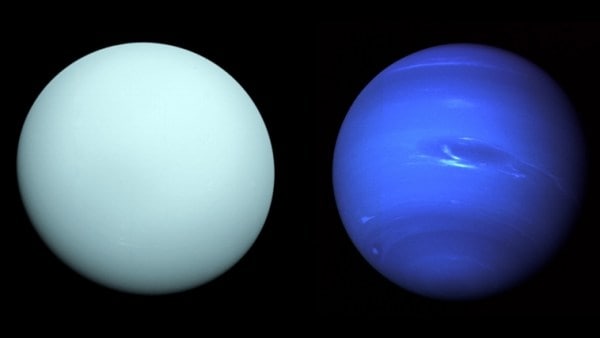VOYAGER MISSION
1. Context
More than a week after the National Aeronautics and Space Administration (NASA) lost communication with Earth’s longest-running space probe, Voyager 2, the space agency detected a “heartbeat” signal from the spacecraft on Tuesday (August 1 2023)
2.About Voyager mission
- In 1972, NASA cancelled its plans of exploring the five outer planets (Mars, Jupiter, Saturn, Uranus and Neptune) with four highly complex spacecraft the proposal, estimated to cost $ 1 billion, was scrapped due to budgetary constraints
- Instead, it proposed to send the Voyager probes, initially slated to explore only Jupiter and Saturn
- In 1974, however, it was decided that if one spacecraft completes the mission, the other one would be redirected towards Uranus and then Neptune
- Interestingly, the spacecraft were scheduled for a take-off towards the end of the 1970s for a reason
- According to a report by Scientific American, NASA chose the particular launch window to take advantage of a rare alignment of Jupiter, Saturn, Uranus and Neptune that occurs once every 175 years

- The alignment allowed the spacecraft to harness the gravity of each planet and swing from one to the next using relatively minimal amounts of fuel.
- NASA first demonstrated the technique with its Mariner 10 mission to Venus and Mercury from 1973 to 1975
- Voyager 2 was launched on August 20, 1977, two weeks before the September 5 Voyager 1 takeoff.
- This reversal of order took place as the two spacecraft were put on different trajectories Voyager 1 was set on a path to reach Jupiter and Saturn, ahead of Voyager 2
3. Features of Voyage Mission
- Voyager 1 and Voyager 2 are identical spacecraft. Each of them is equipped with instruments to carry out 10 different experiments
- The instruments include television cameras to take images of planets and other celestial bodies infrared and ultraviolet sensors, magnetometers, plasma detectors, and cosmic-ray and charged-particle sensors.

- Both spacecraft feature a large antenna, 3.7 metres in diameter, which is used to receive commands from Earth and radio their findings back to the planet
- As their mission involved going far away from the Sun, they aren’t powered by solar power, like other spacecraft are
- Instead, Voyager relies on a small nuclear power plant, drawing hundreds of watts from the radioactive decay of a pellet of plutonium
- Notably, each Voyager spacecraft is adorned with a golden phonograph record a 12-inch disc, intended to be a sort of time capsule from Earth to any extraterrestrial life that might intercept the probes in the distant future
4. Achievements of Voyager spacecraft
- Fifteen months after its launch, Voyager 1 reached its first target planet, Jupiter, on March 5, 1979, and was soon followed by Voyager 2, which arrived there on July 9
- The most interesting discoveries made by Voyager 1 included the finding that Io, one of Jupiter’s moons, was geologically active
- The spacecraft noted the presence of at least eight active volcanoes “spewing material into space, making it one of the most (if not the most) geologically active planetary bodies in the solar system,”
- Moreover, Voyager 1 and Voyager 2 discovered three new moons of Jupiter: Thebe, Metis and Adrastea
- Following the Jupiter encounter, the spacecraft, one by one, moved towards Saturn. While passing by the planet’s moon Titan, Voyager 1 discovered that it wasn’t the biggest moon of our solar system, contrary to what scientists of the time believed — “the diameter of the solid centre was found (through radio signals) to be smaller than Jupiter’s Ganymede”

Jupiter by Voyage
Image Source: Wikimedia
- After the Saturn expedition, as Voyager 1 headed on a trajectory to escape the solar system, Voyager 2 was redirected towards Uranus — both probes had fulfilled their primary mission goals but scientists kept them operational for further exploration

Saturn by Voyage
Image Source: Wikimedia
- Voyager 2 arrived at Uranus in 1986, becoming the first human-made object to fly past the aquamarine planet.
- The spacecraft took stunning photographs and confirmed that the main constituents of Uranus are hydrogen and helium.
- It also discovered 10 new moons and two new rings in addition to the previously-known nine rings, among other significant findings

Uranus and Neptune by Voyage
- Then, the probe went to Neptune. Becoming the first human-made object to fly by the planet in 1989, Voyager 2 made some more notable discoveries there
- Apart from finding new moons and rings, it discovered that Neptune is more active than previously thought winds on the planet blow at the speed of 1,100 kph.
- after the Neptune encounter, Voyager 2, like Voyager 1, was put on the path to head out of the solar system.
- While Voyager 1 officially entered interstellar space in August 2012, Voyager 2 made its entry in November 2018
5. Way forward
Although most of the instruments on the spacecraft aren’t operational, Voyager probes have been transmitting data back to Earth over the years — it is only after the recent glitch that Voyager 2 has stopped sending back the data but scientists hope to regain full communication with the spacecraft soon. But eventually, there will not be enough electricity to power both probes. After that, Voyager 1 and Voyager 2 will silently continue their journey among the stars
|
For Prelims: Voyage mission, Mars, Saturn
For Mains: 1.India's space program has demonstrated successful frugal innovation. Elaborate on the cost-effective approaches adopted by the Indian Space Research Organization (ISRO) in its space missions.
2.Evaluate the ethical considerations and concerns related to space exploration, including issues of space debris, potential contamination of celestial bodies, and commercialization of space
|
Source: indianexpress




